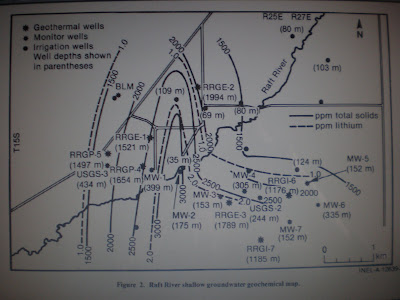
THE WASATCH LINE AND THE HURRICANE FAULT CANNOT BE DISTINGUISHED ALONG MOST OF THEIR COMMON PATH. However, whenever Hf departs FROM the Great Basin and Range, B&R, fault (which is the same as the Wasatch line in this location) vulcanism emerges in the opening or separation of the two entities. This separation occurs at the Black Ridge area near Anderson Junction of the freeway I-15. This Hiway and the B&R lateral rotation exists in a saddle, which is the mark of faulting. When the lateral faulting turns to the SW toward ST. George, it departs Hf, and there is extension of the CRUST- ALLOWING EXTRUSION OF BASALTS (mainly vents, but the Pine Valley Mountains is an expression of the same feature- extension allowing intrusion).
BELOW IS A SIMPLIFIED MODEL FOR THE MOVEMENTS OCCURRING ALONG THE HURRICANE FAULT, Hf, IN THE VICINITY OF THE TOWN OF HURRICANE- which is an introduction to movements in the local area:

A photo is shown below, exhibiting the main directions of movement in the I-15 freeway area. Vents occur not only near the Anderson Junction, but along the Clock-wise rotation under the Virgin River (the Grass Valley extrusions lie to the south of this divergence): The case of Hawaii- shown at the top introduction- took a bit more time to completely de-cipher, since the geology culture has published so much literature that the true nature is overwhelmed by large budgets, speculation about “hotspots“, plate theory, and hand-waving. With my third try, I finally found the relationship, by RESORTING TO ANALYSIS OF THE SMALLEST CORIOLIS DIVERGENCE- THAT EXISTING JUST OUTSIDE MY WINDOW- looking east toward the Hurricane fault. I have found that this is the location to investigate everything one needs to know about CORIOLIS CELLS, VULCANISM, GREAT FAULT MOVEMENTS, SHEAR ALONG CIRCULAR PATHS: HOT SPRINGS, ZONES OF BETTER-THAN-AVERAGE PERMEABILITY OF AQUIFERS, FRACTURE PATTERNS, UPLIFT, TILTING OF SEDIMENTARY BEDS, SHALLOW METAMORPHISM AND HEAT OF BRITTLE FRICTION.

THE CASE FOR YELLOWSTONE RHYOLITIC VULCANISM IS INTRODUCED VIA A PLOT OF THE PROGRESSION OF THE EXTRUSIONS WITH TIME (ALTOGETHER ABOUT 13 MILLION YEARS, FOR 13 SITES OF EXTRUSION IN IDAHO AND NEVADA-UTAH). THESE MOVE TO THE ENE WITH GEOLOGIC TIME, AND EACH IS AT THE NORTH OF A NEW VALLEY IN THE BASIN AND RANGE (WHICH ALSO NUMBER 13-14 DIFFERENT BASINS).

YELLOWSTONE GEOTHERMAL AREA:
 IT SEEMS FAIRLY CERTAIN THAT THE MOVEMENT OF THE SIERRAS TO THE WEST CREATES EXTENSION OF THE B&R, AND OPENS A LARGE FRACTURE OR LATERAL FAULT IN THE LOWER CRUST WHICH ALLOWS THE MANTLE BELOW TO EXTRUDE THROUGH THE SILICEOUS CRUST.
IT SEEMS FAIRLY CERTAIN THAT THE MOVEMENT OF THE SIERRAS TO THE WEST CREATES EXTENSION OF THE B&R, AND OPENS A LARGE FRACTURE OR LATERAL FAULT IN THE LOWER CRUST WHICH ALLOWS THE MANTLE BELOW TO EXTRUDE THROUGH THE SILICEOUS CRUST. 

The case of Yellowstone is essentially the same AS THAT FOR THE SMALLER VENTS AND EXTRUSIONS- a divergence of the crust, creating large-scale extension and fracturing, at the more complicated boundary of the northern edge of the EQUATORIAL BULGE, EB, and the westward tidal shove of the Sierras- which opens the B&R to extension (creating the B&R in the process). This is treated in an earlier blog, which can be found under Yellowstone analysis. The zone north of B&R is one with no bulge- hence it moves relatively to the east compared to the Sierras westward shove.

I am also presenting the opposite case- that of two converging Coriolis cells- where there is a Geothermal Anomaly, but one of marginal HEAT (T< 300F). THIS IS AN ANALYSIS done for DOE BY MYSELF IN THE 7O'S. This was drilled for hothouse use, for tomatoes, etc. which was insufficient for electrical power:



Notice that the chemical composition of the produced hot water yields information about the direction of movement and of the orientation of the anomaly:

I will try to discern why the higher elevation mountain chain to the east is rotating CW (sinking, and this could be the case for rapidly-eroding mountains). It is likely (as shown by the local drainage pattern coming off both chains of mountains) that the chain to the east is rotating faster- thereby creating HEAT OF FRICTION.
THIS IS TO BE CONTINUED, LIKE ALL THE OTHERS, SINCE EVERYTHING IS CONNECTED TO EVERYTHING ELSE, AND I GET MORE ACCURATE RESULTS AS I ANALYZE MORE CASES.
















